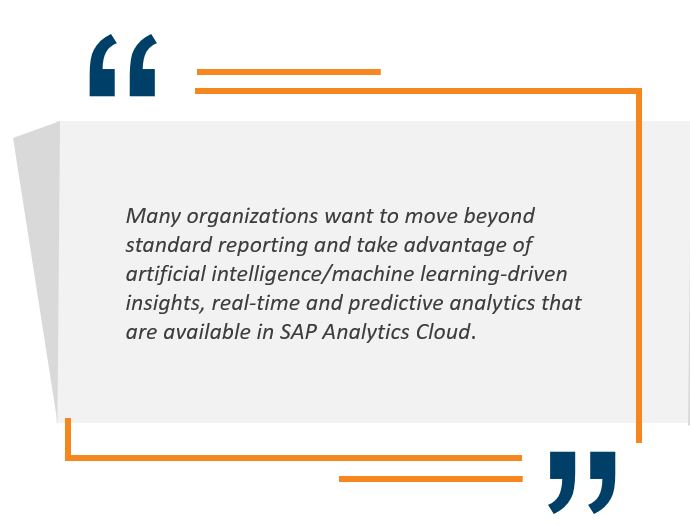Despite the upheaval of COVID-19, the future is not what it used to be. What used to be predictable can now be expected to come with caveats, assumptions and speculations. Regardless, what is important is how we respond now. With the general availability of SAP Business Planning and Consolidation (BPC) 11.1 released last year and other existing BPC versions, it is the perfect time for SAP customers to rethink their overall planning and reporting strategy. SAP BPC remains one of the most widely used enterprise planning solution on the market. With the addition of SAP Analytics Cloud, customers can now create a hybrid solution that leverages the existing investments with the AI/ML-driven insights, easier integration and predictive analytics of SAP Analytics Cloud (SAC).
Why BPC is still important
While future investments in planning will primarily go to SAC, SAP stays committed to their established on-premise planning products while guiding the future in the cloud. There are several key reasons why SAP BPC is still relevant:
- Production scheduled report delivery and distribution to large groups of recipients via portal or book publication
- Integration with flat files and other SAP and non-SAP source systems
- Easy to use creation and maintenance of master data and ad hoc reporting
- All planning, aggregation/disaggregation, consolidation, elimination and/or intercompany capabilities via rules and scripts/ABAP/Fox Code
- Support of planning functions in BW modeling tools
- Planning on advanced data stores (aDSO) and composite providers
- Enhanced data slice settings for planning sequences
- Trigger process chain through new planning function types
- Improved PAK support for key figures/measures
- Support ATRV on HANA views
- How-tos for data slice exit based on BRF+
- Engine preparation: deletion of data from the query
- Vast network of experienced users and consultants
- BPC backbone with real-time SAC collaboration
Why BPC customers should consider adding SAC (i.e., hybrid approach)
 Many organizations want to move beyond standard reporting and take advantage of artificial intelligence/machine learning-driven insights, real-time and predictive analytics that are available in SAP Analytics Cloud. Organizations benefit from the tighter integration between SAP BPC (standard and embedded) and SAP Analytics Cloud with hybrid planning scenarios. While Excel-type reporting is still easy to use and beneficial (also available in SAC), SAC offers a robust analytics solution which enables users to interact with the data, creating dashboards, reports, answering ad-hoc questions and finding insights just by clicking a button. When talking with SAP BPC clients about reasons to consider adding SAC, we often hear the need for these features:
Many organizations want to move beyond standard reporting and take advantage of artificial intelligence/machine learning-driven insights, real-time and predictive analytics that are available in SAP Analytics Cloud. Organizations benefit from the tighter integration between SAP BPC (standard and embedded) and SAP Analytics Cloud with hybrid planning scenarios. While Excel-type reporting is still easy to use and beneficial (also available in SAC), SAC offers a robust analytics solution which enables users to interact with the data, creating dashboards, reports, answering ad-hoc questions and finding insights just by clicking a button. When talking with SAP BPC clients about reasons to consider adding SAC, we often hear the need for these features:
- Integrated AI/ML provides instant insights into data
- Real-time and ad hoc reporting and analytics
- Faster implementations at lower costs
- Software as a Service (SaaS)/Cloud Architecture
- Similar functionality to EPM and analysis for office (AO)
- Consolidation of BI, planning and predictive analytics in one tool
- Integration into numerous cloud and on-premise applications
Clients are satisfied with BPC but want the extra features and functionality of SAC, so why not use them both? As SAC continues to add new features and functionality, organizations can connect SAC to BPC and transaction system(s) and attain real-time analytics and enhanced planning capabilities (e.g. disaggregation, real-time reporting, private versions, etc.). Many of our customers are heading in this direction and are fueled by renewed attention in effective planning without having to make any heavy investments in equipment.
Our client, National Vision, has chosen this hybrid approach and has seen 100% improvement in calculation performance, a 60 percent increase in reporting and planning accuracy and a 20 percent reduction in planning cycle times. The combination of BPC and SAC allows the company to gain a clearer view into its financial reporting that enables scenario forecasting to see the real-time impact of key business drivers.
Why move SAP planning to the cloud
In addition to adding the capabilities of SAP Analytics Cloud, this is also the perfect time to supplement existing investments. More and more companies are transitioning to the cloud, perhaps due to the trust and reputation it enjoys while benefiting from the cost savings, stability, scalability and security.
By combining cloud infrastructure with third-party managed services like those offered by Protiviti, businesses can outsource time-consuming and tedious tasks like administration, security, monitoring and support to allow BPC consolidations, planning and BI teams to focus on more important activities like data quality and insights. COVID-19 will continue to have a huge impact for the foreseeable future, so planning activities must increase in frequency and variability to accommodate this dynamic environment. This will allow a bridge between older BPC technology and SAC while the business retools itself.
Making it even easier to move SAP Analytics Cloud, Protiviti offers a prebuilt environment such as our extended planning and analysis accelerator (xP&A), which will help to accelerate implementation time and reduce cost and risk.
How to get started
To allow organizations to tap into their existing investment in planning and analytics, SAP is allowing customers to exchange some or all their BusinessObjects (BOBJ) and/or BPC maintenance for SAP Analytics Cloud subscriptions. Protiviti and SAP will collaboratively perform an assessment with existing SAP BPC and BusinessObjects licenses. After this quick evaluation, companies will know exactly how much “trade-in” credit is available and will receive both a recommendation for SAC licensing and an estimate for an SAC pilot project that includes training, data connectivity, security implementation and a business use-case.
If you are interested in having a BPC/SAC assessment or would like to discuss further the topics provided in this blog, please contact us directly.
To learn more about our SAP capabilities, contact us or visit Protiviti’s SAP consulting services.






